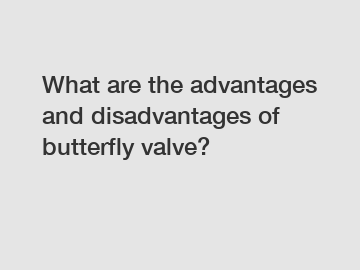What are the advantages and disadvantages of butterfly valve?
Butterfly valves are a popular type of valve used in various industries due to their wide range of advantages. However, like any other technology, they also have their fair share of disadvantages. In this blog post, we will explore the advantages and disadvantages of butterfly valves, providing you with a comprehensive overview of their benefits and limitations. Whether you are a professional in the field or simply curious about valves, this article will provide you with valuable insights.
Advantages of Butterfly Valves:
1. Cost-effective: Butterfly valves are relatively inexpensive compared to other valve types such as gate or ball valves. Their simple design and fewer components contribute to lower manufacturing and maintenance costs.

2. Space-efficient: Compared to other valves, butterfly valves require less space for installation. Their compact design and low weight make them an excellent choice for applications where space is limited.
3. Quick and easy operation: Butterfly valves offer fast and easy operation due to their quarter-turn mechanism. They can be fully opened or closed by rotating the disc by just 90 degrees, providing efficient flow control.
4. Energy efficiency: With a disc that offers minimal flow obstruction when fully open, butterfly valves provide excellent flow capacity, resulting in lower energy consumption and reduced pumping costs.
5. Versatility: Butterfly valves are highly versatile and can be used in various industries, including HVAC, water treatment, food and beverage, pharmaceuticals, and many more. They are suitable for both high and low-pressure applications.
6. Reliable sealing: Butterfly valves provide reliable sealing, thanks to their unique sealing mechanism. With a rubber or elastomeric ring that forms a tight seal, these valves are less susceptible to leakage compared to other types.
Disadvantages of Butterfly Valves:
1. Limited control: Although butterfly valves offer quick and efficient flow control, they may not be suitable for applications requiring precise throttling or precise control over flow rate. The quarter-turn operation limits their ability to regulate flow accurately.
2. Pressure limitations: In high-pressure applications, butterfly valves may experience performance limitations. The operating pressure range for butterfly valves may not be as wide as other valve types, such as gate or globe valves.
3. Temperature limitations: Extreme temperatures can affect the performance of butterfly valves. High temperatures can cause the lining material to deteriorate, while low temperatures can lead to brittleness and reduced flexibility.
4. Slurry and abrasive resistance: Butterfly valves are not the best choice for applications involving slurry or abrasive media. The disc's sealing surface can wear down or become damaged when exposed to abrasive particles, compromising the valve's performance and sealing capability.
5. Limited service life: Compared to other valves, butterfly valves may have a shorter service life due to wear and tear caused by frequent operation. However, advancements in valve design and materials have significantly improved their durability and longevity.
6. Flow turbulence: In certain applications, butterfly valves may create more flow turbulence compared to other valve types. This can lead to increased pressure drops, energy losses, and potential damage to downstream equipment.
In conclusion, butterfly valves offer numerous advantages such as cost-effectiveness, space efficiency, quick operation, energy efficiency, versatility, and reliable sealing. However, they also have limitations concerning precise control, pressure and temperature limitations, resistance to slurry and abrasive media, service life, and flow turbulence. It is crucial to carefully consider these factors when selecting a valve for a specific application.
Remember, the suitability of a butterfly valve depends on the unique requirements of the system it will be used in. Consulting with a valve expert or manufacturer can ensure that you make an informed decision based on your specific needs. By understanding the advantages and disadvantages, you can determine if a butterfly valve is the right choice for your intended application.
Are you interested in learning more about rising stem gate valve vs non rising stem, China ball valve with pneumatic actuator of water supplier, China ball valve actuator pneumatic factory? Contact us today to secure an expert consultation!


